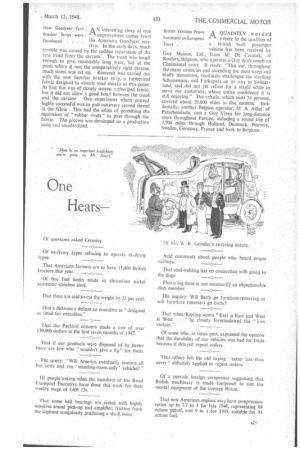Passing Comments
Page 24

Page 25

If you've noticed an error in this article please click here to report it so we can fix it.
A Simple Plan to WRITING from Southern
Help the Smaller " Rhodesia, Mr. M. W.
Operators , . . Harris, managing director of
Burrows Transport, Ltd., expresses considerable concern at the collapse of the fight against nationalization and the fact that some important companies are hastening to be taken over. He feels that the tide might be stemmed if the associations could put up a plan to the Government whereby the independent road operators would retain their licences on condition that they did not undercut Government rates.. Thus the railways would be protected. We much doubt now, however, whether any such delayed action would greatly influence the course of events so far as long-distance transport is concerned.
An Accident Which nN the road one occasionally Might Have Had ‘-fsees remarkable accidents, Serious Effects . . and one we observed recently in High Street, Kensington, certainly comes into this category. A bus was about to pass a stationary car when the latter drew out and proceeded in a curve across the road to enter a by-road on the opposite side. The bus driver said he did not see any signal given and thought that the car was merely pulling out to pass another stationary 1. chicle in front of it. He therefore swerved to the off side and went right across the road in an endeavour to avoid hitting the car, but eventually damaged it severely at the front so that it turned around and shot off again to the near side, finishing up at right angles to the kerb. Meanwhile, the bus, could not brake sufficiently to stop, and ran on to the off-side pavement between a tall lamp post and the premises of a bank. It scraped along the front of the latter, A71 making scores in the stonework, ran along the pavement for a little way and finished up with its forward part on the road and its back still on the pavement. Fortunately, it being evening, the pavement was clear and no one in or out of either vehicle was hurt beyond slight bruising. This was an exceptionally clever example of driving on the part of the busman, and many people marvelled at the comparatively slight damage done, particularly as there seemed barely room for the bus between the lamp standard and the bank. A lamp was brok-en off the bus and the near-side wing dented where it hit the car, but not a window was even cracked, despite damage to the off side of the driver's cabin.
Many British Vehicles WE referred recently to the Employ Magnetic " fact that the American
Filters Ford Co. is now employing magnetic drain plugs for the engines of its vehicles, these being for the purpose of collecting ferrous particles. In this connection, Simms Motor Units, Ltd., reminds us that it has been making for many years gearbox, back-axle and engine-drain plugs having magnetic filters, and that these are being fitted as standard by a large proportion of the heavy-vehicle producers in Britain. We had not forgotten this fact, but it was interesting to note that one of the larger concerns in America had; apparently, only recently adopted the system. Iron and steel particles, often too small to be adequately filtered in the ordinary way,may cause a lot of damage, as may chips from gear teeth. There are, of course, no filters in gearboxes and back axles, therefore the damage from such particles in. these may be even greater. Thus these little magnetic devices prove most helpful in reducing costs.
How Goodyear Tyre A N interesting story of tyre Breaker Strips were improvement comes from Developed . . . . the American Goodyear con cern. In the early days, much trouble was caused by the sudden separation of the .tyre tread from the carcase. The tread was tough enough to give reasonably long wear, but at the point where it met the comparatively rigid carcase, much stress was set up. Research was carried out with the now familiar breaker strip, a rubberized fabric designed to absorb road shocks at this point. At first this was of closely woven rubberized fabric, but it did not allow a good bowl between the tread and the carcase One experiment which proved highly• successful was to pull out every second thread in the fabric This had the effect of permitting the equivalent of" rubber rivets" to pass through the fabric. The process was developed on a production scale and standardized.
British Vehicles Prove Successful on European Tours . .
A QUAINTLY worded tribute to the qualities of
a British built passenger
vehicle has been received by Guy Motors, Ltd., from M. De Cettnick, of Routers, Belgium, who operates a Guy Arab coach on Continental tours. It reads: " This car, throughout the many countries and ascending the most steep and bluffy mountains, resolutely challenged the startling Schussenpass and Furkapass on its way to Switzerland, and did not yet refuse for a single while to serve our customers, whose entire confidence it is still enjoying" The vehicle, which seats 34 persons, covered about 28,000 miles in five months. Meidentally, another Belgian operator, M A. Aillet. of Passehendaete, uses a Guy Vixen for long-distance tours throughout Europe, including a round trip of 3,700 miles through Holland, Denmark, Norway, Sweden, Germany, France and back to Belgium.


















































































